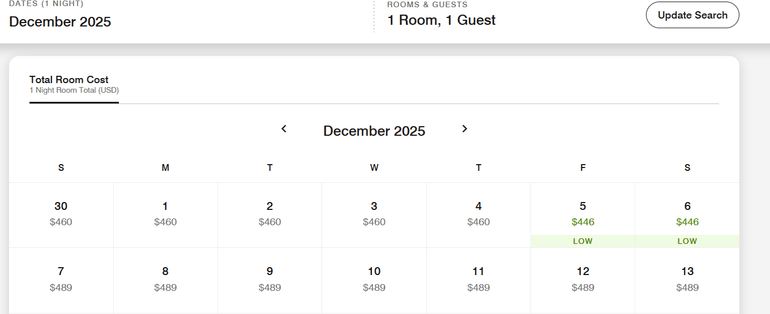Are The Marriott Vacation Clubs Worth It?
The Marriott Vacation Clubs, a collection of timeshare brands, has its own points system and properties.

Many or all of the products on this page are from partners who compensate us when you click to or take an action on their website, but this does not influence our evaluations or ratings. Our opinions are our own.
The Marriott Vacation Clubs is an extensive vacation timeshare program, encompassing three brands and more than 90 properties around the world. Marriott Vacation Club is one of the three brands, which has both villa resorts as well as urban destinations that are part of its City Collection.
What makes ownership into The Marriott Vacation Clubs different than a hotel loyalty program is that when you become an owner with The Marriott Vacation Clubs, you become an owner of a real estate trust product, and receive an annual allotment of points to use at member properties each year.
🤓 Nerdy Tip
You do not have to be a Marriott Vacation Clubs member to stay at some of these properties. Some Marriott Vacation Clubs let non-timeshare holders book a stay using cash or Marriott Bonvoy points. They would also earn Marriott Bonvoy points during their cash stay. Not everyone will find The Marriott Vacation Clubs to be right for them, but there is tremendous value for those who prioritize taking an annual vacation to any of its villa destinations. It comes with the promise of Marriott quality, which makes belonging to The Marriott Vacation Clubs worthwhile rather than taking a chance on an Airbnb or standard resort visit elsewhere.
How does The Marriott Vacation Clubs work?
Timeshare programs may be different between brands, but the gist is that they sell owners an allotment of points that can be redeemed at a vacation property each year.
The Marriott Vacation Clubs properties use dynamic pricing, so the number of points you need varies by time of year, location and demand.
The annual allotment of Club points can be used whenever the owner likes at whatever Clubs property they prefer. It does not have to be the same week every year like old-school timeshare programs.
The Marriott Vacation Clubs owners can also transfer up to 20,000 points per year to someone else.
Club ownership can sometimes be a more affordable way to book larger accommodations (like suites and villas) rather than paying outright, but only for those who know they will take a vacation to one of the participating properties each year.
An added bonus of going to the same property is that owners build relationships with the staff members there, making it feel more like home (without having to worry about operational costs like regular upkeep or gardening that you might have with buying a vacation home).
The Marriott Vacation Clubs cost
There are several fees that are part of being an owner in Marriott’s timeshare program. These include:
- An ownership package starting at $27,000 depending on the number of Vacation Club points you want to buy.
- Annual maintenance fees and club dues to cover repairs, real estate taxes or insurance premiums.
If you are not able to use all of your points during a given year, you can transfer them to someone else or roll them over to the next year. And if your vacation plans are larger than expected, you can also borrow points from the next year to cover a trip. This flexibility can add a lot of value for someone who can commit to taking an annual vacation.
» Learn more: The best travel credit cards right now
The Marriott Vacation Clubs properties

The Marriott Vacation Clubs properties are all over the world, including in the U.S., Caribbean, Central America, Europe, Australia and Asia.
They look and feel like traditional hotels and resorts, and many of them host guests paying normal nightly rates. These properties include standard rooms, studios, and villas with multiple bedrooms and kitchen amenities.

You’ll find the expected hotel perks like pools, gyms, spas, restaurants and other on-site amenities, with the offer varying by location.
Abound by Marriott Vacations
Instead of physical hotels, owners can opt to use their points to visit partner resorts or for travel packages by tour operators in Marriott’s network. Owners can use their points at the Harborside Resort at Atlantis Paradise Island Bahamas or the Four Seasons Country Club in the Quinta do Lago Resort in Portugal through the exchange program.
Abound by Marriott Vacations is an exchange program in which owners can book nearly 2,000 experiences from The Explorer Collection. This could include things like cruises, safaris and guided tours. For example, you can stay in a 13th-century stone abbey in Ireland or take an exotic cruise to new places.
The City Collection
The City Collection is a group of urban properties in The Marriott Vacation Clubs network and serves as a great option for those who don’t always go to a resort when they travel. The Marriott Vacation Club property in Washington, D.C., is the Mayflower Hotel, a historic landmark that opened in 1925. Other city properties are in destinations including New York, San Francisco and the newest one, Waikiki.
Marriott Bonvoy points. vs. Marriott Vacation Club points
Marriott Bonvoy points are different from Club points. Marriott Bonvoy points can be earned by staying at Marriott hotels or spending on Marriott co-branded credit cards, and they can be redeemed for participating hotels in the Marriott Bonvoy loyalty program.
Marriott Vacation Clubs points, on the other hand, are a separate type of currency. Owners of The Marriott Vacation Clubs purchase Club points, which can be redeemed for stays at Club properties or for tours or special experiences though the Explorer Collection.
Owners can use their Club points each year, bank them to use the next year, transfer them to someone else, exchange them with another program or convert them to Marriott Bonvoy points to redeem for a hotel stay.
What is staying at a Marriott Vacation Club like?

I visited Marriott Vacation Club, Waikiki, in January 2025 at the invitation of Marriott Vacation Club, which covered the cost of my stay. The opinions below of the newly opened Waikiki location are my own.
The property attracts vacationers as well as business travelers who want to be in the heart of the action. According to the hotel, this property is also popular as a pre- or post-visit to other Marriott Vacation Club villa resorts in Hawaii. People like pairing a traditional beach vacation with a little urban excitement, and they use Honolulu as their primary gateway to the islands.

It was my first time staying at a resort that focused on timeshare guests, and it surprised me how much the experience was like that of a traditional hotel.
The studios and guest villas (more like suites with separate living areas, laundry facilities and small kitchens) are bright and airy. All of the expected amenities like toiletries, towels, slippers and housekeeping were all in place.

There is a panoramic fitness center on the top floor along with the highest infinity pool in all of Waikiki that looks out toward the beach. Grills are available for guests to use for free. There is also a grill restaurant that is open from lunch through dinner. Live music takes place three times a week.

There are also cabanas to rent (which come with charcuterie plates and refreshments) and fire pits where guests can enjoy a cocktail to watch the sunset.

City Insiders are a key part of the City Collection properties. They act like concierges but can also take you on walking tours or lead property experiences. The City Insider team at Waikiki hosts history and culinary tours around the downtown area as well as things like lei making classes and Hawaiian cultural activities.

The per-night cost of a stay in December is about $450 to $489, and there is no resort fee. This is a deal for travelers looking for accommodations with a kitchen.
Different brands in The Marriott Vacation Clubs
Like Marriott Bonvoy’s many brands, there are also numerous Vacation Club brands within the portfolio.
The Marriott Vacation Clubs includes:
- Marriott Vacation Club.
- Sheraton Vacation Club.
- Westin Vacation Club.
The Marriott Vacation Clubs is a portfolio of vacation ownership brands and is operated by Marriott Vacations Worldwide. These are the brands under Marriott Vacations Worldwide:
- The Marriott Vacation Clubs (which includes Marriott Vacation Club, Sheraton Vacation Club and Westin Vacation Club).
- Hyatt Vacation Club.
- Grand Residences by Marriott.
- The Ritz-Carlton Club.
- St. Regis Residence Club.
You can find a variety of accommodations, from family-oriented experiences at the Sheraton Vacation Club to chic destination stays at The Ritz-Carlton Club.
Being an owner and having part of a deeded real estate interest is not ideal for those who do not take a vacation each year. The benefit is that you are paying just for the time (the points that you use to redeem a stay) you need. But you have to travel to benefit.
If you cannot travel due to work or school constraints, or simply a matter of budget, The Marriott Vacation Clubs is only as good as you make it, and that requires making time to travel.
You don’t need to go to the same place each year, and you can take a break one year and move points to the next year. You can also choose another of the Marriott family of brands that participates in The Marriott Vacation Clubs. But if taking a vacation is a luxury that you cannot usually afford, timeshare ownership is not the best way to travel.
Should I join The Marriott Vacation Clubs?
If you don’t mind staying connected to one network of properties (or its affiliates) and visiting one at least once per year, then The Marriott Vacation Clubs could be a way to save on annual stays, but you have to be able to pay for much of the costs upfront in joining The Marriott Vacation Clubs and paying annual dues.
How to maximize your rewards
You want a travel credit card that prioritizes what’s important to you. Here are some of the best travel credit cards of 2026:
- Flexibility, point transfers and a large bonus: Chase Sapphire Preferred® Card
- No annual fee: Wells Fargo Autograph® Card
- Flat-rate travel rewards: Capital One Venture Rewards Credit Card
- Bonus travel rewards and high-end perks: Chase Sapphire Reserve®
- Luxury perks: American Express Platinum Card®
- Business travelers: Ink Business Preferred® Credit Card
Article sources
NerdWallet writers are subject matter authorities who use primary,
trustworthy sources to inform their work, including peer-reviewed
studies, government websites, academic research and interviews with
industry experts. All content is fact-checked for accuracy, timeliness
and relevance. You can learn more about NerdWallet's high
standards for journalism by reading our
editorial guidelines.
More like this
Related articles









